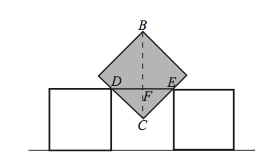Difference between revisions of "2005 AMC 10A Problems/Problem 19"
| Line 2: | Line 2: | ||
Then you have to add the 1 from the height of the other two squares, so you get <math>1+BF=\sqrt{2}+\dfrac{1}{2}</math>. | Then you have to add the 1 from the height of the other two squares, so you get <math>1+BF=\sqrt{2}+\dfrac{1}{2}</math>. | ||
| + | |||
| + | [[File:AMC10200519Sol.png]] | ||










